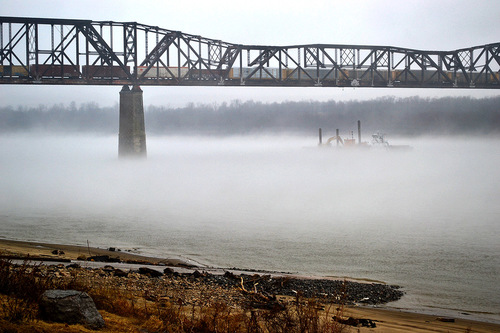A foggy game of chicken
 You're the captain of a shipping boat making your approach to harbor, and you're close to your delivery deadline. To finish the delivery, you have to sail underneath a bridge that closes every so often in order to let ships through in the other direction. Exactly
seconds before the bridge closes, a light turns from green to yellow to indicate ships to use caution. Because of the heavy fog, you can't see the light until you're a distance
from the bridge, at which point you determine it is yellow.
You're the captain of a shipping boat making your approach to harbor, and you're close to your delivery deadline. To finish the delivery, you have to sail underneath a bridge that closes every so often in order to let ships through in the other direction. Exactly
seconds before the bridge closes, a light turns from green to yellow to indicate ships to use caution. Because of the heavy fog, you can't see the light until you're a distance
from the bridge, at which point you determine it is yellow.
If you make it through the bridge before it closes (in which case your delivery will be early) you receive a bonus of $100,000. If the light turns red (indicating the passage is closed) before you pass through, you must bring the ship to a complete stop (to avoid crashing). If you do this, you shed all of the kinetic energy your ship had, and you'll have to spend fuel to bring it back up to the original cruising speed.
What cruising speed, (in m/s), should your ship maintain to maximize the expected value of passing under the bridge?
Details
- Your ship weighs kg
- Your on-time bonus is $100,000
- For simplicity, assume that the price of fuel is /kJ
- m
- s
The answer is 4.472.
This section requires Javascript.
You are seeing this because something didn't load right. We suggest you, (a) try
refreshing the page, (b) enabling javascript if it is disabled on your browser and,
finally, (c)
loading the
non-javascript version of this page
. We're sorry about the hassle.
The ship captain can have one of two outcomes: he makes it under the bridge before it closes, or he doesn't. If the ship captain decides to go very slow ( v → 0 , he'll almost never make the bridge and will always pay the penalty, but it will be rather small (low KE). On the other end, as he goes faster and faster, he decreases the likelihood that he'll have to stop, but he also increases the cost of having to stop.
What is the chance that the captain successfully makes it under the bridge? This is equal to the chance that there are d / v seconds left before the light turns from yellow to red . Since the light turned at a random time between the present and t ∗ ago, this chance is 1 − d / v t ∗ . In making it, the captain gets paid the bonus γ B for being early.
The chance that the captain doesn't make it is just the complement of making it, i.e. d / v t ∗ . Not making it means the captain has to dissipate all the ship's kinetic energy, ≈ 2 1 M v 2 , which costs γ E per kJ to replenish (in fuel). The total cost is therefore γ E 2 1 M v 2 .
It is clear from this analysis that the cost rises more quickly than the chance of not making it decreases (as v goes to high values), and therefore we expect some kind of balance point between low and high v that results in the greatest expected worth.
To find the expected worth W of attempting to cross under the bridge at a given speed v , we weight the value of each outcome by its probability of occurrence:
W = γ B ( 1 − v 1 t ∗ d ) − γ E 2 1 M v 2 v 1 t ∗ d
Let's plot the expression as a function of v :
We see that for very slow speeds, the expected value drops precipitously. For very high speeds, the value drops more gradually. For moderate speeds v , there is a zone where we expect to profit by passing under the bridge.
We can find the optimal speed by setting the derivative of W with respect to v equal to zero:
∂ v ∂ W = 0 = γ B v 2 1 t ∗ d − γ E m t ∗ d
From this, we find v ∗ = m 2 γ E γ B , which for the given values, yields v ∗ ≈ 4 . 4 7 m/s .
We might expect that the shorter the period t ∗ is, or the longer the distance d is, the faster the ship should go. Somewhat surprisingly, this speed is entirely independent of the value of d or t ∗ , or even their ratio. The length and distance have no bearing on the optimal speed. Their only contribution is to set the absolute value of the expected worth, and the speed is determined solely in terms of the cost of fuel γ E , the bonus γ B , and the mass of the ship m .